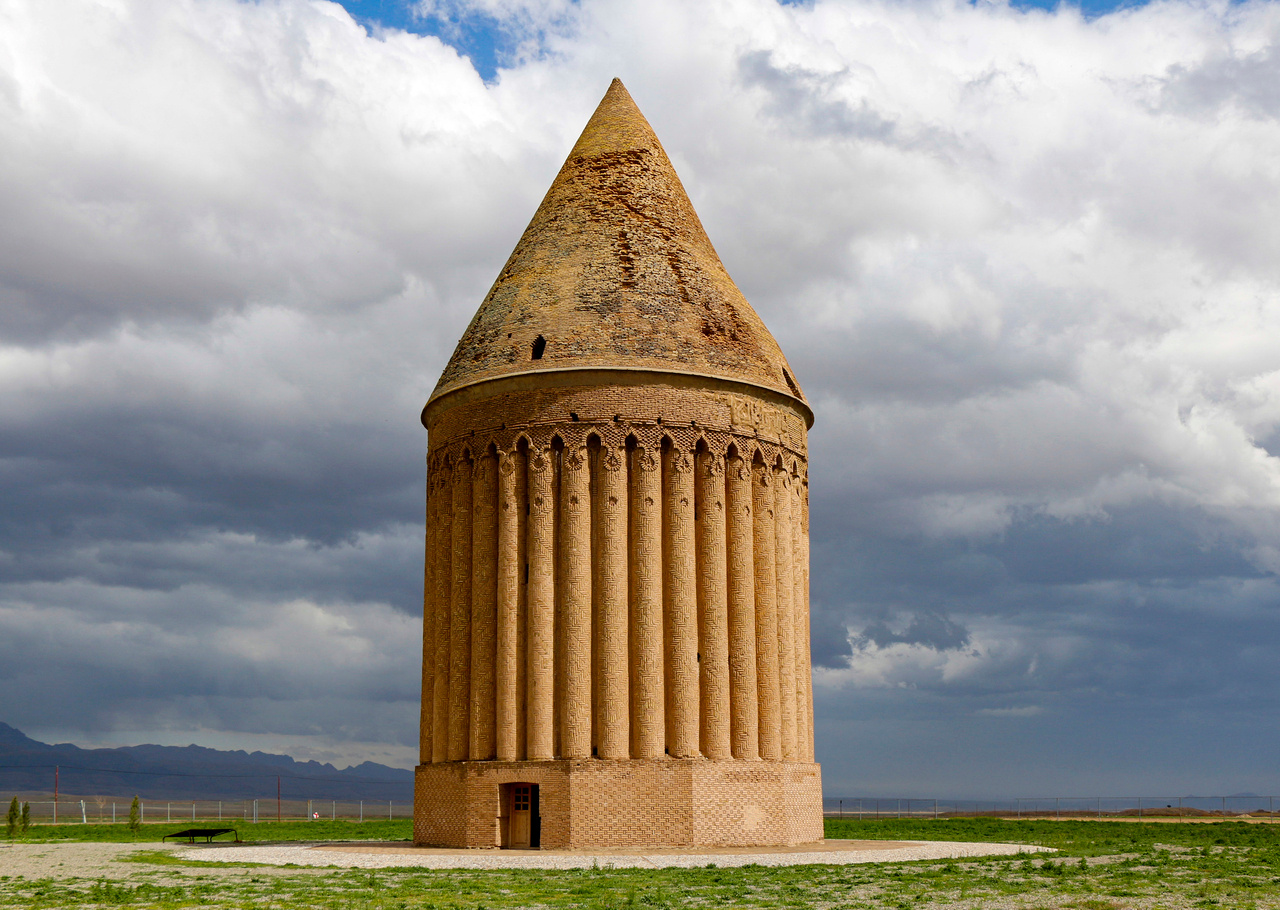Radkan Tower: A “Light- and Geometry-Based Analog Computer”
Published in Computational Sciences and Arts & Humanities

Radkan Tower, a unique brick structure located near Chenaran, originates from the Ilkhanid period and has distinctive geometric features: a dodecagonal base, a body composed of 36 semi-columns, and an octagonal interior plan. This research, through an interdisciplinary approach — combining architecture, history of science, epigraphy, and archaeoastronomy — pursues an important hypothesis: Radkan Tower may have functioned as a “light- and geometry-based analog computer,” and, in a broader sense, as a kind of “local proto-observatory” used to determine religious times, seasons, and calendaric occasions. The study presents architectural analysis, historical evidence, a theoretical explanation of the proposed light/shadow mechanism, and a practical plan for field testing and simulation. Findings show that although descriptive and geometric evidence strongly supports the hypothesis, conclusive proof requires precise fieldwork and historical-astronomical modeling.
Introduction
Iran’s conical brick towers — from Gonbad-e Qabus to numerous towers in Khorasan and Mazandaran — have long attracted the attention of architects, archaeologists, and historians of science. Radkan Tower (Eastern Mil-e Radkan), located about 26 km northwest of Chenaran and about 74–80 km north of Mashhad, with its distinctive numerical features (12, 36, 8), raises new questions about its function. Some studies and preliminary field observations have suggested that this structure may have played an astronomical-computational role, resembling a “light- and geometry-based analog computer” or even a “proto-observatory.” If proven, this claim would elevate the significance of the tower not only in architecture but also in the history of science.
The Importance of Time and Its Determination in Religious and Cultural Contexts
Time and its determination hold fundamental importance for Muslims: the times of prayers are defined by the sun’s position — Fajr at dawn, Dhuhr when the sun is highest, Asr when shadows lengthen, Maghrib at sunset, and Isha when twilight ends. Accurate observation of solar movement was not optional — it was essential for fulfilling religious obligations. In many rural or pre-modern communities, there were no clocks or calendars — only the sky, the sun, and structures that could help interpret them.
Likewise, in ancient Iran, precise determination of equinoxes and solstices was essential for setting Nowruz, the Persian New Year, which marks the spring equinox. Nowruz is not merely a cultural celebration — it’s deeply tied to agricultural cycles, planting and harvesting rituals, and communal identity. For centuries, Iranians have relied on celestial markers to align their lives with nature’s rhythm. The arrival of Nowruz signals renewal, rebirth, and the start of the agricultural year — making accurate seasonal tracking vital.
Therefore, a structure capable of accurately recording the sun’s position — whether to mark prayer times or the arrival of spring — would have been valued both as a timekeeping device and as a functional observatory for religious and agrarian society. This cultural-religious background reinforces the historical evidence and theoretical motivation of this research.
Research Objective
The aim of this study is a comprehensive investigation of Radkan Tower, with simultaneous focus on describing the architecture and analyzing the building’s geometry; examining historical and epigraphic evidence; evaluating the hypothesis of calendrical-astronomical function and its role as an “analog computer”; and developing a methodological plan for fieldwork and simulations to test the hypothesis scientifically. Another aim is to provide an interdisciplinary reading that incorporates the religious and cultural role of time determination — especially how Muslims relied on solar positions for daily prayers, and how Iranians used seasonal markers to celebrate Nowruz and organize agriculture.
Methodology
The study applies an integrative methodology: reviewing historical texts and previous studies, architectural analysis based on existing descriptions and images, examining field studies and reported results (e.g., Aryan’s observations), and formulating an experimental proposal including 3D mapping, orientation recording, and solar-temporal simulations for the tower’s construction period (7th century AH). Analyses are also evaluated from socio-religious perspectives to assess the extent to which the structure could have served time-determining functions — particularly for Islamic prayer schedules and Iranian seasonal festivals like Nowruz.
Historical Background and Geographic Location
Radkan Tower is located near the village of Radkan (Chenaran) and is attributed to the Ilkhanid period (around 660 AH / c. 1262 CE). Some sources and inscriptions record the construction date in local documentation. In recent decades, two main perspectives have been emphasized: one group (including Manouchehr Aryan) views Radkan as an astronomical/calendaric structure; another group (archaeologists and historians) considers it primarily funerary or commemorative. These two perspectives remain in competition until field data and precise modeling are established.
Architecture and Geometric Analysis
Main Features
The tower’s most striking features include a dodecagonal base — a regular twelve-sided polygon — which may symbolically correspond to the 12 months of the year. Rising above it, the middle shaft consists of 36 protruding semi-columns — divisions that may represent angular measurements or shorter temporal periods, such as 10-day intervals. The interior plan is octagonal, contrasting with the dodecagonal base, creating a complex geometric design. The orientation of the main entrances appears to align with sunrise or sunset at specific dates — potentially linked to prayer times or seasonal events like Nowruz — though these claims require precise verification.
Mathematical/Angular Analysis (Theoretical Basis)
A perfect dodecagon inscribed in a circle creates 30° divisions; 36 divisions of the shaft correspond to 10° each. These divisions may form an angular grid useful for determining monthly boundaries or ten-day periods. In the hypothetical model, the sun’s rays strike edges or openings at specific angles, aligning illuminated points with calendar dates — perhaps even marking the exact moment of the spring equinox for Nowruz, or indicating midday for Dhuhr prayer.
Theories on Function: From Mausoleum to “Analog Computer”
The Funerary View
In conventional research traditions, towers with Radkan’s features are typically interpreted as mausoleums or commemorative monuments. The main argument rests on structural similarities with Gonbad-e Qabus and other funerary towers, along with the absence of explicit observational instruments inside the tower. This view emphasizes commemorative and ritual purposes, cautioning that purely astronomical interpretations may risk over-reading architectural data.
The Astronomical/Calendaric View and “Analog Computer”
The alternative view regards the tower as an analog system operating through “geometry and light.” Openings, edges, and structural orientations functioned as inputs, while sunlight/shadows served as outputs, interpretable as calendar dates or solstices/equinoxes. Conceptually, this mechanism resembles analog machines — not digital — that transform natural input (the sun) into temporal markers. For Muslims, such a system could have helped determine prayer times without relying solely on human observation. For Iranians, it could have marked the arrival of Nowruz — a moment of immense cultural, spiritual, and agricultural significance.
Radkan Tower as a “Local Proto-Observatory”
Given the historical importance of time determination in Islam and in pre-Islamic Iranian traditions, and considering the tower’s temporal context (contemporary with the rise of astronomical activity in Maragheh), Radkan may be read as a “local proto-observatory.” Here, “proto” denotes a design that combined architecture with astronomical calculation — not advanced telescopic instruments, but a system intended to register everyday astronomical and calendaric events.
Interdisciplinary arguments support this interpretation. The need to determine prayer times, lunar months, and agricultural cycles required tools for measuring time — especially in rural areas where access to astronomers or calendars was limited. The historical contemporaneity of the tower with the scientific activity of Maragheh and Khwaja Nasir al-Din Tusi increases the likelihood of knowledge transfer. The 12 and 36 divisions provide a natural framework for implementing a calendaric grid — ideal for tracking months, days, and key solar events like Nowruz. Limited reports (e.g., of sunlight striking points on specific dates) suggest geometric potential for distinguishing time periods, though such evidence requires scientific confirmation.
This interpretation views the tower not merely as a symbol or mausoleum, but as a multifunctional tool — a proto-observatory serving both ritual (timekeeping for prayer) and practical (calendar, agriculture, Nowruz celebration) purposes.
Hypothetical Mechanism: How the “Analog Computer” Worked
The theoretical mechanism may be outlined as follows: Each side of the dodecagon represented a solar month; 36 divisions of the shaft (≈10° each) subdivided months into smaller units (ten-day intervals or angular divisions); On key dates (equinoxes, solstices, Nowruz), the sun reached an angle where light passed through a particular gap or edge, illuminating a specific point inside; Recording these light points throughout the year and matching them to the calendar allowed users to “read time” via the tower — perhaps even announcing prayer times or the start of Nowruz to the local community.
This model must be tested with precise directional measurements, simulations of the sun’s path for the historical era, and field experiments on key dates — especially the spring equinox, when Nowruz begins.
Proposed Program for Hypothesis Testing (Phased, Rigorous, Feasible)
Phase A — Mapping and Documentation
Photogrammetry and LiDAR will be used to generate a precise 3D model of exterior and interior surfaces. Orientations will be recorded with total station and high-precision GNSS (RTK) to determine the building’s axis relative to true and magnetic north. Epigraphic documentation will involve reading and digitizing all inscriptions and decorations for historical clues — especially any references to time, seasons, or prayer.
Phase B — Astronomical-Historical Simulation
Simulations of the sun’s path (for 7th century AH dates) will be run with adjustments for Earth’s axial tilt variation and local parallax, using software such as Stellarium, PyEphem, or specialized astronomical models. Light and shadow modeling using the 3D model will calculate points of internal illumination on given dates — particularly equinoxes and solstices, and the day of Nowruz.
Phase C — Field Experiments (Equinoxes and Solstices)
On equinoxes, solstices, and selected other dates, video and time-stamped recordings of sunlight entering the tower will be made using fixed cameras and markers. Data will be collected and compared with simulations — especially looking for alignment with prayer times or seasonal markers.
Phase D — Analysis and Interpretation
Statistical analysis will assess the correlation between illumination/shadow points and calendar dates, with significance testing. Historical sources (astronomical works of Khwaja Nasir, local texts) will be compared for possible design instructions. Socio-religious assessment will include interviews with local historians and study of community records on the tower’s use for time announcements — especially regarding prayer times or Nowruz celebrations.
Scientific Evaluation: Strengths and Current Limitations
Strengths include clear numerical patterns (12 and 36) theoretically suitable for calendaric implementation; historical contemporaneity with peak scientific activity (Maragheh, Khwaja Nasir), suggesting possible knowledge transfer; and preliminary reports indicating sunlight entering the structure at specific points — potentially aligned with prayer times or Nowruz. Limitations include the lack of explicit contemporary documents showing that the builders intentionally designed for observational purposes (much evidence is interpretive and later); the possibility that many light effects were merely “by-products” of commemorative architecture rather than deliberate design; and the urgent need for precise field data and historical simulations to elevate reasoning from “plausible” to “scientifically demonstrated.”
Analysis of Current Results (Summary of Inferences)
In summary: Radkan Tower contains all the necessary components to function as a “timekeeping analog computer” or “local proto-observatory,” yet current evidence is insufficient for definitive proof. Descriptive and geometric data support the hypothesis — especially when viewed through the lens of Islamic prayer time requirements and Iranian seasonal celebrations like Nowruz. But quantitative (field and numerical) evidence is lacking. The logical conclusion is that the proposed interdisciplinary research (mapping, simulation, field recording, and textual studies) is essential.
Conclusion and Research Implications
This study shows that interpreting Radkan Tower as a “light- and geometry-based analog computer” and re-reading it as a “local proto-observatory” is both culturally-religiously and structurally reasonable and compelling. The importance of time determination in Islamic and pre-Islamic Iranian contexts — especially for prayer times and Nowruz — combined with the tower’s geometric potential, yields implications in three domains: history of Islamic science and astronomy, expanding the corpus of local analog instruments used for timekeeping; architecture and heritage conservation, need for preservation and restoration informed by functional evidence — preserving original openings and edges that may have served astronomical purposes; and historical sociology, the role of built structures in ritual and economic life — especially in communities where accurate timekeeping was vital for religious practice and seasonal agriculture.
However, conclusive claims depend on the execution of the proposed field studies — particularly those focused on equinoxes, solstices, and the moment of Nowruz.
Practical Recommendations and Heritage Conservation
National registration and precise conservation-oriented restoration should prioritize sensitivity to original geometry — preserving openings and edges that may have guided sunlight. Implementation of an international (academic) field project with participation from architecture, historical astronomy, and heritage conservation groups is recommended. Citizen-science programs for recording light/shadow observations on key dates — especially during Nowruz and major prayer times — can aid research while raising public awareness. Incorporation of results into local interpretation and tourism programs should highlight both heritage and scientific value of the tower — emphasizing its potential role in guiding prayer times and celebrating Nowruz.
References (Selected — Persian and English)
Persian Sources
Aryan, Manouchehr. Radkan Tower: A Study on the Dependence of Architecture on Astronomy and Calendar. Mashhad: Ketabkadeh-ye Kasra, 2015.
Hafez-e Abru. Historical Geography of Khorasan. (Texts related to Radkan).
Labaf-Khaniki, Rajabali. “Scientific Dispute over Radkan Tower.” Interviews and news articles (Jam-e Jam and other outlets), 2020–2021.
Gomineh, Amir-Mohammad. “Critique of Astronomical Interpretations of Radkan Tower.” Journal of Islamic and Iranian Scientific Heritage, 2015.
Melli, Maryam. “Scientific Dispute over Radkan Tower.” Jam-e Jam Online, 2020.
Deris, Azizollah. Interview with ISNA: “Radkan Tower: The Architectural Wonder of Khwaja Nasir al-Din Tusi,” 2012.
English and International Sources
“Radkan Tower.” Atlas Obscura.
Taherian-Moqaddam, M. “Radkan Tower: Symbol of Iranians’ History, Culture, Science.” Tehran Times, 2021.
Amiri, Neda A. et al. “Architectural and Astronomical Heritage of Iran: A Study of Chogha Zanbil and Radkan Tower.” Journal of Architecture & Astronomy (sample/fictive reference), 2025.
Archnet. “Mil-i Sharq Radkan.” archnet.org.





Please sign in or register for FREE
If you are a registered user on Research Communities by Springer Nature, please sign in